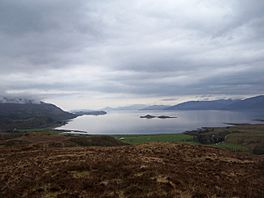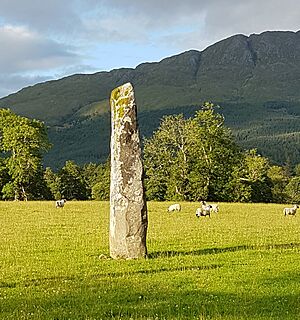Cuil Bay facts for kids
Quick facts for kids Cuil Bay |
|
|---|---|

The bay from the lower slopes of Ardsheal Hill
|
|
| Location | Duror, Argyll and Bute Scotland |
| Coordinates | 56°38′41.3160″N 5°18′31.0428″W / 56.644810000°N 5.308623000°W |
| Native name | A' Chùil Error {{native name checker}}: parameter value is malformed (help) |
| River sources | River Duror Salachan Burn |
| Ocean/sea sources | Loch Linnhe |
| Basin countries | Scotland |
| Max. length | 2.67 km (1.66 mi) |
| Max. width | 1.77 km (1.10 mi) |
| Average depth | 32 m (105 ft) |
| Islands | Eilean Balnagowan, Shuna |
| Settlements | Duror, Keil, Achara, Cuil |
Cuil Bay (Scottish Gaelic: A' Chùil) is a beautiful bay in Scotland. Its name means "recess" or "nook" in Scottish Gaelic. This large bay has a sandy and shingle beach. It is shaped like a half-circle.
Cuil Bay is located on the south-west side of the Ardsheal peninsula. It sits on the southern coast of Loch Linnhe, which is a sea loch. The bay is very close to the village of Duror. You can reach it by a small road from Duror Primary School. This road follows the River Duror as it flows towards the sea.
Contents
Exploring Cuil Bay's Location
Cuil Bay faces towards Loch Linnhe. This large sea loch is partly hidden by the Ardsheal peninsula. The bay itself is on the western edge of this peninsula.
From Cuil Bay, you can easily see the small island of Eilean Balnagowan. It is about 2 kilometers away. Behind Eilean Balnagowan, you can spot Shuna Island. Shuna Island is about 7.42 kilometers from the beach. The Sound of Shuna, which is the water between Shuna and the Appin coast, is also visible.
On a clear day, you might even see the north coast of Lismore Island. Lismore is about 13.71 kilometers from the north end of Cuil Bay. Cuil Bay is part of an old area in Scotland called Lorne.
Fishing for Salmon at Cuil Bay
Near the north-west end of Cuil Bay, there's a special place for Salmon fishing. People here use an old method called "set bag net" fishing. This way of fishing has been used in Cuil Bay for about 400 years! This shows how important it is to Scotland's history.
The main type of salmon caught here is the Atlantic salmon. The fishing method uses a fixed net that traps fish. It's considered an environmentally friendly way to fish. This is because fishermen can choose to keep or release fish. They decide based on the fish's size, weight, and health. Other seafood like langoustine and prawn are also caught nearby using pots.
Amazing Wildlife and Nature
Cuil Bay is a great place for a special insect called the giant tachinid fly. This fly looks a lot like a bumblebee when it flies! The area around the bay has many dry, open meadows and heaths. These are perfect places for the flies to breed. They lay their eggs from February to September. These flies are parasites, meaning they lay their eggs on large caterpillars.
Protected Areas Around Cuil Bay
Cuil Bay is part of two important protected areas. These areas help keep the nature and geology safe.
- Special Protected Area (SPA): This area is called Glen Etive and Glen Fyne. It was set up on September 28, 2010. It protects important groups of breeding birds, especially the golden eagle (Aquila chrysaetos).
- Site of Special Scientific Interest (SSSI): This area is the Ardsheal Peninsula. It was named on February 1, 1981. It is important for its unique rocks (called igneous petrology) and how the land has changed over time (called metamorphic geology).
Stories and History of Cuil Bay
Cuil Bay is even mentioned in old Scottish stories! In the The Dewar Manuscripts, there's a tale about a "hospitality house" in Cuil. This house belonged to the Lord of the Isles. The person living there didn't pay rent. Instead, they had to prepare a huge feast whenever the Lord visited.
One time, the tenant, a man named McTavish, was told to get a feast ready. But the River Etive was flooded, so the Lord was delayed. Dugald MacIain Stewart of the Clan Stewart of Appin told McTavish the Lord wouldn't come. So, McTavish and his friends ate the feast!
When the Lord finally arrived a few days later, there was no feast. But Stewart quickly prepared a new one. As a reward, the Lord gave Cuil to Stewart. The Lord of the Isles then said to McTavish:
O! Big gluttonous MacTavish, Whose ways are filthy; Though I have taken from you Cuil Dear, do not harm yourself.
The Ancient Achara Stone
Near the start of the small road to Cuil Bay, you'll find a very old standing stone. It's located in a field across from Duror Primary School. This stone has been standing there for at least 5,000 years! It's about 12 feet (3.7 meters) tall. This stone gave its name to the nearby area, Achara (Scottish Gaelic: Achadh a' charraigh).
Images for kids








